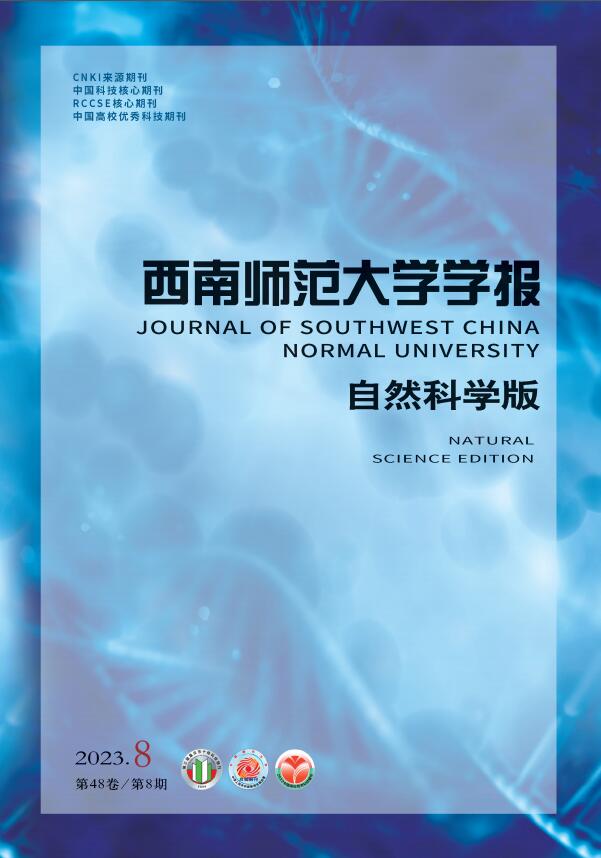-
本文所指的Minkowski空间(V,F),可以认为是具有光滑范数F的n+1维线性空间V,其中n≥2,但只假设范数具有正齐次性. Finlser流形的切空间均为Minkowski空间. 由于Minkowski空间是内积空间的自然推广,因此Finsler流形可以认为是没有二次型限制的黎曼流形[1-2]. Minkowski空间V0=V\{0}上具有自然的Hessian型黎曼度量
$\widehat{\mathit{\boldsymbol{g}}}=\frac{1}{2} D \mathrm{d}\left[F^2\right]$ .文献[3]做出如下猜测(Laugwitz猜测):如果黎曼流形(V0,
$\widehat{\mathit{\boldsymbol{g}}}$ )的曲率张量为0,那么F2为二次多项式. 文献[4]在假设F具有绝对齐次性的条件下运用分析手段解决了Laugwitz猜测. 文献[5]采用几何方法,利用Blaschke-Santaló不等式将文献[4]的结果推广到了F的单位球的重心在原点的情形.我们首先证明黎曼流形(V0,
$\widehat{\mathit{\boldsymbol{g}}}$ )的曲率张量为0等价于Minkowski空间(V,F)单位球面的中心仿射度量h具有常截面曲率1. 众所周知,F2为二次多项式等价于(V,F)的单位球面为椭球面. 于是Laugwitz猜测的等价形式为:如果原点在内部的闭凸超曲面的中心仿射度量具有常截面曲率1,则该超曲面为椭球面. 在此基础上,利用仿射等周不等式,本文给出文献[5]的结果的一个新证明.定理1 [5] Minkowski空间(V,F)单位球面在中心仿射度量下的体积与同维数的标准欧氏球面的体积相同,并且F的单位球的重心在原点,那么F2为二次多项式.
对于凸超曲面有中心仿射法化诱导的仿射联络▽,定义3-形式
$\hat{\boldsymbol{C}}=-\frac{1}{2} \nabla \boldsymbol{h}$ . 众所周知$\widehat{\mathit{\boldsymbol{C}}}$ =0的超曲面为二次曲面[6-8]. 3-形式$\widehat{\mathit{\boldsymbol{C}}}$ 关于度量h的迹称为Tchebychev形式,记作$\widehat{\mathit{\boldsymbol{T}}}$ ,其对偶向量场T称为Tchebychev向量场. 对于原点在内部的闭凸超曲面,Blaschke-Deicke定理表明$\widehat{\mathit{\boldsymbol{T}}}$ =0蕴涵着$\widehat{\mathit{\boldsymbol{C}}}$ =0. 文献[9]在研究中心仿射超曲面的体积变分时定义$\mathscr{T}=\nabla^h \boldsymbol{T}$ 为超曲面的中心仿射Tchebychev算子(或中心仿射形状算子),并称$\boldsymbol{H}=\frac{1}{n} \operatorname{tr} \mathscr{T}$ 为超曲面的中心仿射平均曲率. 如果原点在内部的闭凸超曲面具有常平均曲率H,文献[9]证明了该超曲面为椭球面. 作为推论可知,如果原点在内部的闭凸超曲面的Tchebychev向量场为Killing向量场,则该超曲面为椭球面. 文献[10]证明了上述结果对于Tchebychev向量场为共形向量场的情形也成立. 定义$\widetilde{\mathscr{T}}=\nabla^h \boldsymbol{T}-\boldsymbol{H} \cdot \mathrm{id}$ 为算子$\mathscr{T}$ 的无迹部分,称为无迹Tchebychev算子,那么T为共形向量场当且仅当$\widetilde{\mathscr{T}}$ =0. 我们利用极大值原理证明了如下结果:定理2 Minkowski空间(V,F)单位球的中心仿射度量具有常截面曲率并且
$\nabla^{\boldsymbol{h}} \tilde{\mathscr{T}}=0$ ,那么F2为二次多项式.这里采用的方法与文献[11]的方法相同,主要是计算Simon 3-形式
$\mathit{\boldsymbol{\widetilde C}}$ 的模长平方的Laplace,因为常截面曲率的假设,使得计算变得更加简单. 我们发现这里的计算在常Ricci曲率的假设下也有效,相关的结果将在后续的研究中加以说明. 另外,条件$\nabla^{\boldsymbol{h}} \tilde{\mathscr{T}}=0$ 的几何意义及分类问题也是值得研究的课题,对于Laugwitz猜测的研究也非常有价值. 这类问题的研究是仿射微分几何的经典主题,文献[12]研究了平行Simon 3-形式的强凸相对超曲面的分类问题,更系统的研究可以参见文献[6].
HTML
-
本文中,Minkowski空间指具有光滑的强凸Minkowski范数F的n+1维实向量空间V,且n≥2. 其中Minkowski范数F指函数V [0,+∞),满足:
(ⅰ) 正则性:F在V上连续,在V0=V\{0}上光滑;
(ⅱ) 正齐次性:
(ⅲ) 强凸性:对于任意非零向量y ≠0,
正定.
V0上的黎曼度量
$\hat{\boldsymbol{g}}=\hat{\boldsymbol{g}}_{i j}(\boldsymbol{x}, \boldsymbol{y}) \mathrm{d} \boldsymbol{y}^i \otimes \mathrm{d} \boldsymbol{y}^j$ 显然是Hessian形度量[12]. 在Finsler几何中通常定义Cantan张量为Hessian度量
$\widehat{\mathit{\boldsymbol{g}}}$ 的联络系数与Cantan张量的关系式为根据Hessian几何的标准结果可知
$\widehat{\mathit{\boldsymbol{g}}}$ 的Riemann曲率张量为关于Hessian流形较为详细的研究可进一步参见文献[13].
-
接下来,本文主要考虑Minkowski空间(V,F)的单位球面
单位球面IF在黎曼流形(V0,
$\widehat{\mathit{\boldsymbol{g}}}$ )中的超曲面几何的讨论可参见文献[1]. 本文将从中心仿射几何的观点研究单位球面IF. 事实上,单位球面IF的这两种几何是完全相同的.下面简要介绍超曲面的中心仿射几何结构. 事实上,仿射空间中非退化超曲面的中心仿射几何是相对微分几何的一个特殊情形,关于相对微分几何的理论可参见文献[6-8]. 我们将从参数化超曲面的角度给出中心仿射几何的一种描述.
设
$\mathit{\boldsymbol{f}}: U \longrightarrow \mathbb{R}^{n+1}$ 为嵌入映射,其中U是$\mathbb{R}^{n}$ 中的连通开域. 那么M= f(U)称为$\mathbb{R}^{n+1}$ 中的嵌入超曲面. 本文假设M非退化,且其上有中心法化诱导的$G L(n+1; \mathbb{R})$ 不变黎曼度量h,称为中心仿射度量,$\mathit{\boldsymbol{f}}(\mathit{\boldsymbol{p}}) \in M$ 处的切空间${\mathit{\boldsymbol{T}}_{\mathit{\boldsymbol{f}}(\mathit{\boldsymbol{p}})}}$ 由$\left\{\left.\frac{\partial \boldsymbol{f}}{\partial \boldsymbol{x}^1}\right|_\mathit{\boldsymbol{p}}, \cdots, \left.\frac{\partial \boldsymbol{f}}{\partial \boldsymbol{x}^n}\right|_\mathit{\boldsymbol{p}}\right\}$ 张成,此外,我们假设向量场f与M处处横截,即对任意p ∈U构成
$\mathbb{R}^{n+1}$ 的一组基. 则f的Hessian具有以下分解:设
${\nabla _{\frac{{\partial \mathit{\boldsymbol{f}}}}{{\partial {\mathit{\boldsymbol{x}}^i}}}}}\frac{{\partial \mathit{\boldsymbol{f}}}}{{\partial {\mathit{\boldsymbol{x}}^j}}} = \mathit{\boldsymbol{ \boldsymbol{\varGamma} }}_{ij}^k\frac{{\partial \mathit{\boldsymbol{f}}}}{{\partial {\mathit{\boldsymbol{x}}^k}}}$ ,则▽在TM上定义了一个无挠的仿射联络. 另外,$\boldsymbol{h}=\boldsymbol{h}_{i j} \mathrm{~d} \boldsymbol{x}^i \otimes \mathrm{d} \boldsymbol{x}^j$ 在TM上定义了一个半黎曼度量. 在本文中,我们只考虑h是正定的情况. 易知▽和h均为$G L(n+1; {\mathbb{R} })$ 不变量.对方程(3)两边再求一次导数,可得
根据
以及▽的曲率定义
从(4)式,我们得到
令
$\widehat{\mathit{\boldsymbol{C}}}= -\frac{1}{2} \nabla \boldsymbol{h}$ ,那么在局部坐标系下容易证明
$\widehat{\mathit{\boldsymbol{C}}}$ 是全对称的(0,3)-形张量.令
$\boldsymbol{C}=\nabla-\nabla^\boldsymbol{h}$ ,其中▽h是h的Levi-Civita联络. 用$\tilde{\mathit{\boldsymbol{ \boldsymbol{\varGamma}}}}_{i j}^k$ 记▽h的联络系数,因此因为▽hh =0,由(7)式可知
根据(6)式,可知
因此,我们得到
由(7)式容易得到联络▽和▽h的曲率之间的关系
此处
$\tilde{\boldsymbol{R}}$ 表示▽h的曲率张量,Cij, kl表示▽hC的系数. 从(5)式和(9)式,我们可以得到根据张量的对称性,(10)式等价于下面两个方程:
和
这里的(11)和(12)两式即为超曲面中心仿射几何的结构方程.
此外,Tchebychev形式
$\widehat{\mathit{\boldsymbol{T}}}$ 定义为3-形式的迹$\widehat{\mathit{\boldsymbol{T}}}$ 关于h的对偶向量场T称为Tchebychev向量场.下面的引理1给出了Minkowski空间(V,F)的几何量与单位球面IF的中心仿射几何量之间的关系.
引理1 [14] 对于Minkowski空间(V,F),设i:IF→V是单位球面IF的嵌入映射. 对每个点v ∈IF,如果选择
$\boldsymbol{y}=-\boldsymbol{v} \in \boldsymbol{T}_v V$ 以及$\boldsymbol{Y}=-\mathrm{d} F \in \boldsymbol{T}_\boldsymbol{v}^* V$ ,那么{Y,y}给出了IF上的中心仿射法化. 进一步,中心仿射度量和3-形式满足根据引理1,可得下面的引理:
引理2 对于给定的Minkowski空间(V,F),黎曼流形(V0,
$\widehat{\mathit{\boldsymbol{g}}}$ )平坦当且仅当IF的中心仿射度量具有常截面曲率1.证 根据黎曼流形(V0,
$\widehat{\mathit{\boldsymbol{g}}}$ )曲率张量的表达式(1)以及3-形式与Cartan张量的关系式(14),可知$\mathit{\boldsymbol{\hat R}} = {\bf{0}}$ ,蕴涵在IF上成立. 根据(12)式可知,IF的中心仿射度量的曲率张量满足
即IF的中心仿射度量具有常截面曲率1. 另外,只需注意到Cartan张量的齐次性,上述过程反过来即可给出充分性的证明.
根据引理2可知,Laugwitz关于Minkowski空间的猜测[3]可等价转化为闭凸超曲面的唯一性问题.
1.1. Minkowski空间的黎曼几何
1.2. Minkowski空间的单位球面的中心仿射几何
-
本节将在n+1维线性空间V上附加一个欧式内积〈,〉. 对于V中的闭超曲面,我们将用欧氏超曲面几何量来表示中心仿射几何量. 令D是一个原点在内部的凸体,假设边界
$M=\partial D$ 光滑. 设M的欧氏外法向量为ξ. 令Ⅰ和Ⅱ分别为M的第一和第二基本形式. 令▽e为第一基本形式Ⅰ的Levi-Civita联络,令ω(Ⅰ)表示第一基本形式Ⅰ下的体积元. 令ρ(v)=〈v,-ξ(v)〉为M的支撑函数. M的Guass曲率有如下表示:引理3 M的中心仿射度量h可用欧氏几何量表示为
中心仿射度量h的体积元ω(h)可表示为
Tchebychev形式
$\widehat{\mathit{\boldsymbol{T}}}$ =dτ,其中τ为Tchebychev势函数仿射联络与欧氏联络▽e的关系为
中心仿射3-形式
$\widehat{\mathit{\boldsymbol{C}}}$ 可以表示为证 令X,Y为M上的两个向量场,那么有
其中
$\bar{\nabla}_{\boldsymbol{X}} \boldsymbol{Y}$ 是向量场Y和X在平坦联络$\bar{\nabla}$ 下的协变导数,第一个等号是$\bar{\nabla}_{\boldsymbol{X}} \boldsymbol{Y}$ 关于中心仿射法化的分解,第二个等号是$\bar{\nabla}_{\boldsymbol{X}} \boldsymbol{Y}$ 关于欧氏法化的分解.用ξ对(21)式两边做内积,可得
整理后便得到(16)式. 进一步,根据(15)和(16)式,可得
因此(17)式成立.
我们将V上由内积诱导的体积元记作Det,M上由中心仿射法化和Det诱导的体积元ω可表示为
由于Tchebychev形式
$\widehat{\mathit{\boldsymbol{T}}}$ =dτ,而$\tau=\frac{1}{n} \ln \left|\frac{\omega}{\omega(\boldsymbol{h})}\right|$ ,由(17)和(22)式可得(18)式.另外,由(16)和(18)式容易得到
因此(19)式成立. 而(20)式是(19)式和(6)式的直接推论.
定理1′ 对于原点在内部,边界为光滑强凸超曲面的凸体D,若D的重心在原点且M=∂D的在中心仿射度量下的体积为同维数欧氏球面的体积,则M为椭球面.
证 根据文献[15],D的n+1-仿射表面积为
由(17)式可知,
$\mathit{\Omega}_{n+1}(D)=\int_M \omega(\boldsymbol{h}) \mathrm{d} M$ 正是M在中心仿射度量下的体积.根据仿射等周不等式[15],可知
其中ωn为欧氏空间
$\mathbb{R}^{n+1}$ 中标准球面Sn的体积,等号成立当且仅当D是中心在原点的椭球. 定理1′得证.根据引理1可知定理1与定理1′等价.
从定理1的证明可知,仿射等周不等式在Laugwitz猜测的研究中有重要意义,如何获得更加一般的几何不等式是一个亟待研究的课题,这方面的研究方法很多,其中曲率流是很有效的方法[16-20].
-
设M为
$\mathbb{R}^{n+1}$ 中的非退化超曲面,而h是M上的中心仿射度量. 设{e1,…,en}是相对于度量h的局部幺正标架场,其对偶标架场为{θ1,…,θn}.在标架场{θ1,…,θn}下,超曲面M的结构方程(12)可表示为
超曲面M的Simon 3-形式
$\mathit{\boldsymbol{\widetilde C}}$ 定义为3-形式C的无迹部分,其中
超曲面M的中心仿射Tchebychev算子定义为
$\mathscr{T}=\nabla^h \boldsymbol{T}$ ,无迹Tchebychev算子定义为$\mathscr{T}$ 的无迹部分$\tilde{\mathscr{T}}=\mathscr{T}-\frac{1}{n} \operatorname{tr} \mathscr{T} \cdot \mathrm{id}$ .引理4 设M为
$\mathbb{R}^{n+1}$ 中的非退化超曲面,如果M的中心仿射度量h具有常截面曲率c>0,且具有平行无迹Tchebychev算子$\nabla^{\boldsymbol{h }}\tilde{\mathscr{T}}=0$ ,那么其中Δh表示由度量h给出的Laplace算子.
证 直接计算可得
其中
$\Delta^{\boldsymbol{h }} \tilde{\boldsymbol{C}}_{k i j}=\sum\limits_t \tilde{\boldsymbol{C}}_{k i j, t t}$ 为Simon 3-形式的Laplace. 在下面的计算中我们将省略求和符号,重复指标默认为求和.根据(11)和(24)式可知,在适当的标架场下,有
由Ricci恒等式可知
由(27)和(28)式以及假设
$\nabla^{\boldsymbol{h}} \widetilde{\mathscr{T}}=0$ ,我们有假设度量h具有常截面曲率c>0,那么
由(26),(27)和(28)式,可得
由此(25)式得证.
定理2′ 对于
$\mathbb{R}^{n+1}$ 中原点在内部的闭凸超曲面M,如果M的中心仿射度量h具有常曲率c>0,并且具有平行的无迹Tchebychev算子$\nabla^{\boldsymbol{h }}\tilde{\mathscr{T}}=0$ ,那么M是中心在原点的椭球面.证 根据引理4和散度定理可知
因此
$\|\tilde{\boldsymbol{C}}\|^2=0$ . 由(24)式可得根据截面曲率的假设(30)式和结构方程(23)式,可得
由(32)式,可得
结合(31)和(33)式,可知
所以‖T‖2为常数. 因T =▽hτ,而M是闭超曲面,故T必有零点. 所以T = 0. 根据Blaschke-Deicke定理可知定理2′成立.
同样,根据引理1可知定理2与定理2′等价.






 DownLoad:
DownLoad: